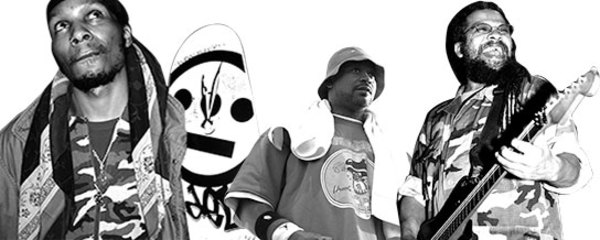Times to Get Ill
In the late ’70s and early ’80s, the nascent punk and hip-hop scenes–arguably contemporary pop […]
Times to Get Ill
In the late ’70s and early ’80s, the nascent punk and hip-hop scenes–arguably contemporary pop […]

In the late ’70s and early ’80s, the nascent punk and hip-hop scenes–arguably contemporary pop culture’s most creative and influential youth-oriented movements–frequently converged, before eventually adopting differing demographics and aesthetics. Or did they? A glance at the last 30 years suggests today’s urban punk/hip-hop hybrid isn’t exactly a new thing.
1977: Bob Marley hangs out with filmmaker/DJ Don Letts in London and releases single “Punky Reggae Party.”
1979: Bad Brains form in Washington, DC.
1981: Grandmaster Flash opens for The Clash in Times Square, inspiring the hip-hop tribute “The Magnificent Seven”; graffiti artist Futura 2000 paints backdrops for The Clash’s European tour, and the band provides musical backing for the single “Futura 2000 and His Escapades”; Blondie releases “Rapture,” which name-drops Flash and Fab Five Freddy and hits #1; Talking Heads offshoots Tom Tom Club release two hip-hoppish singles: “Wordy Rappinghood” and Genius of Love”
1982: Afrika Bambaataa and Soulsonic Force release “Planet Rock,” a huge influence on hip-hop, new wave, and electro; Blondie’s Chris Stein scores Charlie Ahearn’s seminal semi-documentary “Wild Style;” Hip-hop and punk crowds freely mingle at NYC’s Mudd Club.
1983: Cold Crush Brothers release the single “Punk Rock Rap”; graffiti artist turned Warhol celebrity painter Jean-Paul Basquiat executive-produces Rammellzee and K-Rob’s “Beat Bop”; Run-DMC release “Rock Box,” the first rap-rock fusion track, and create the “rapcore” sound (later associated with producer Rick Rubin); former Sex Pistols manager Malcolm McLaren releases Duck Rock, featuring hip-hop crew the World Famous Supreme Team.
1984: Former punk band the Beastie Boys sample AC/DC on their debut Def Jam single “Rock Hard”; Bambaataa teams with ex-Sex Pistol John Lydon for apocalyptic club hit “World Destruction.”
1985: Punk rock photographer, onetime Suicidal Tendencies manager, and skateboarding enthusiast Glen E. Friedman meets Rick Rubin and goes on to shoot influential photos of the Beastie Boys, Run-DMC, LL Cool J., and Ice-T; George Clinton produces the Red Hot Chili Peppers’ Freaky Styley, combining elements of punk, funk, and hip-hop; LA ska-funk band Fishbone releases their debut EP, featuring “Party at Ground Zero.”
1986: Run-DMC release Top Ten single “Walk this Way” with Aerosmith; Beastie Boys’ Licensed to Ill becomes first hip-hop album to go to #1; Nike releases the Air Jordan I, which becomes both a hip-hop fashion statement and a popular skate shoe.
1988: Public Enemy samples Slayer on “She Watch Channel Zero”; NWA releases Straight Outta Compton, which includes the so-rebellious-it’s-practically-punk anthem “Fuck the Police.” Both albums sell millions of units.
1989: Public Enemy teams with hard rock band Anthrax for “Bring the Noize.”
1991: Cypress Hill releases their debut album, which goes over big with both hip-hop and stoner rock crowds.
1992: Ice-T’s Body Count brings a new meaning to “black metal” with their debut album, featuring the controversial song “Cop Killer”; Rage Against the Machine releases their debut album; the Beastie Boys return to their roots with Check Your Head, which trades the sample-heavy style of previous albums for live instrumentation.
1993: Souls of Mischief release 93 ‘til Infinity; Wu-Tang Clan release Enter the Wu-Tang: 36 Chambers. Both become extremely popular with both hip-hop and skate audiences.
1994: Del tha Funky Homosapien releases No Need for Alarm, a seminal influence on alt.rap; Glen E. Friedman publishes Fuck You Heroes, a photobook detailing punk, hip-hop, and skateboarding icons; Rick Rubin produces Johnny Cash’s American Recordings.
1996: Dr. Octagon’s alt.rap classic Octagonecologyst features cover art by Pushead, known for his work with Metallica and other metal/punk bands.
1998: Dancehall don Buju Banton teams with punk superstars Rancid for three songs, including “Life Won’t Wait”; Philadelphian Stevie Williams becomes first African American skateboarder to land a major sponsorship deal (with DC Shoes); Wu-Tang’s clothing line Wu-Wear peaks with $10 million in sales.
2000: Rage Against the Machine covers Minor Threat, the MC5, SoulSonic Force, Cypress Hill, and Eric B. & Rakim on their final studio album, Renegades; Glen E. Friedman co-authors “Dogtown and the Z-Boys,” an account of the early Southern California skateboard scene, which later becomes an award-winning documentary.
2002: The Roots unveil a rock-tinged sound on Phrenology, featuring guitarist Ben Kenney, who later became the bassist in nu-metal band Incubus.
2003: James Spooner’s documentary “Afro-Punk” documents the black rock experience.
2004: Stevie Williams founds DGK–short for “Dirty Ghetto Kids”–and lands distribution deal with Reebok; Platinum producer Pharrell Williams refers to himself as “Skateboard P” on Snoop Dogg’s “Drop it Like It’s Hot.”
2006: Chicago’s Lupe Fiasco releases the skate-themed single “Kick, Push”; The Pack’s “Vans” becomes a MySpace phenomenon, quickly followed by the Diligentz’ “Punk Rock”; former Bones Brigade skater Tommy Guerrero releases From the Soil to the Soul; Zion-I & the Grouch sample the Clash’s “Guns of Brixton” on the song “Trigger” from Heroes in the City of Dope.
2007: The Pack releases their major-label debut album, Based Boys; Bad Brains drop their reunion album, Build A Nation.

